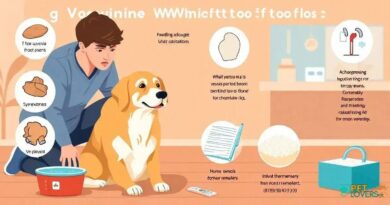What is: Appendicular skeleton in dogs
What is the Appendicular Skeleton in Dogs?
The appendicular skeleton in dogs refers to the part of the skeletal system that includes the bones of the limbs and the pelvic and pectoral girdles. This structure is crucial for mobility and plays a significant role in the overall physical health of a dog. Understanding the appendicular skeleton is essential for dog owners, veterinarians, and anyone involved in canine care and training.
Components of the Appendicular Skeleton
The appendicular skeleton consists of several key components: the forelimbs, hind limbs, and the girdles that connect these limbs to the axial skeleton. In dogs, the forelimbs include the scapula, humerus, radius, and ulna, while the hind limbs comprise the pelvis, femur, tibia, and fibula. Each of these bones has a specific function, contributing to the dog’s ability to run, jump, and perform various physical activities.
Functionality of the Appendicular Skeleton
The primary function of the appendicular skeleton is to facilitate movement. The bones work in conjunction with muscles and joints to allow dogs to perform a wide range of motions, from walking and running to jumping and playing. The design of the appendicular skeleton enables dogs to be agile and responsive, which is vital for their survival and well-being.
Common Injuries to the Appendicular Skeleton
Injuries to the appendicular skeleton are common in dogs, especially those that are active or participate in sports. Fractures, ligament tears, and joint dislocations can occur due to accidents, falls, or overexertion. Recognizing the signs of injury, such as limping or reluctance to move, is crucial for prompt veterinary intervention and treatment.
Importance of the Appendicular Skeleton in Dog Breeds
Different dog breeds may exhibit variations in their appendicular skeletons, which can affect their physical capabilities and health. For instance, larger breeds may have more robust bones to support their weight, while smaller breeds may have lighter, more delicate structures. Understanding these differences can help owners tailor exercise and care to meet the specific needs of their dogs.
Maintaining a Healthy Appendicular Skeleton
To maintain a healthy appendicular skeleton, it is essential to provide dogs with a balanced diet rich in nutrients that support bone health, such as calcium and phosphorus. Regular exercise is also critical, as it strengthens the muscles surrounding the bones and joints, enhancing overall stability and mobility. Additionally, routine veterinary check-ups can help identify any potential issues early on.
Role of Genetics in Appendicular Skeleton Development
Genetics plays a significant role in the development of a dog’s appendicular skeleton. Certain breeds are predisposed to specific skeletal issues, such as hip dysplasia or patellar luxation. Understanding these genetic factors can help owners make informed decisions about breeding, training, and health care to ensure their dogs lead healthy, active lives.
Impact of Age on the Appendicular Skeleton
As dogs age, their appendicular skeleton undergoes changes that can affect mobility and overall health. Older dogs may experience joint degeneration, arthritis, or decreased bone density, leading to increased vulnerability to injuries. Regular veterinary care, appropriate exercise, and dietary adjustments can help mitigate these age-related changes and maintain a dog’s quality of life.
Veterinary Assessment of the Appendicular Skeleton
Veterinarians often perform thorough assessments of a dog’s appendicular skeleton during routine examinations. This may include physical examinations, X-rays, and other diagnostic imaging techniques to evaluate bone health and identify any abnormalities. Early detection of issues can lead to more effective treatment options and better outcomes for the dog’s overall health.
Conclusion: The Appendicular Skeleton’s Role in Canine Health
The appendicular skeleton is a vital component of a dog’s anatomy, influencing their mobility, physical capabilities, and overall health. Understanding its structure and function can help dog owners provide better care and support for their pets, ensuring they remain active and healthy throughout their lives.




